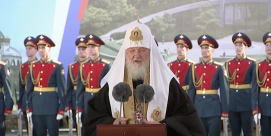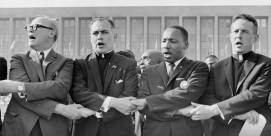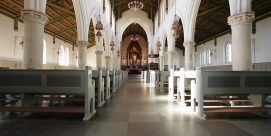In This Episode << SLIDE LEFT TO SEE ADDITIONAL SEGMENTS
Father Marco Antonio Mercado on Hispanic Catholics
Read more of Judy Valente’s interview with Father Marco Antonio Mercado of Good Shepherd Catholic Church in Chicago:
Q: Help us to understand some of the events in the liturgy celebrating the Virgin of Guadalupe, and if you could explain las mañanitas, the Mexican birthday morning song.
A: Well, the mañanitas is very strong tradition, and every time it’s a birthday or it’s a big celebration for someone that you love, we give a serenade, you know, to bring the mariachi or the music to the window for the person that we love in order to sing. The meaning is we want them to hear something beautiful on the first moment, the first second of the day of the celebration. Could be the birthday, the anniversary, or whatever. So that’s why people wait until midnight to go to the house of the beloved one and to sing to the person. It’s the same meaning [in the church]. We want Our Lady the first thing to listen in the morning is the music from her beloved sons and daughters. So that’s the meaning of the mañanitas. It’s a very strong part of the Hispanic tradition, mostly Mexican tradition.
Q: What do some of the words mean?
A: The mañanitas means “in the morning.” And the meaning of the words is how beautiful is the morning that we came here to celebrate with you. It’s so beautiful the day that you were born. And the day that you were born was the same day that all the flowers in the world they were born. And because your day is so special, even the angels and St. Peter and St. Paul, they came to sing to you. And I would like to bring you a star, I want to bring you the sun, I want to bring you the moon, but I couldn’t bring them to you. So I’m here singing to you and wishing you the best thing today on your birthday. Mostly what we celebrate is the day of your saint, because in the Hispanic tradition, mostly when you were born you received the name of the saint of the day. So when the music was composed, that was the same thing — to say you’re celebrating your birthday is the same thing to say you are celebrating your saint.
Q: We saw you bring the children up around the altar. What were you saying to them, and what were the children doing when they raised their hands?
A: I love to do that all the time, to bring the kids so they can participate in the liturgy, in the Eucharist. What I do every time is I explain to them and say, okay, what we have here is just bread or is the body of Christ.
So they answer — half of them say it’s just bread, some say it is the body of Christ. And then I explain to them, I say, well, this is just bread. It’s not yet the body of Christ. We’re going to pray together, we’re going to bless the bread and the wine, and it’s going to become the body and blood of Jesus. So for you to know exactly the moment when this is going to happen, I want you to raise your hands when I raise the chalice and the cup. So you will know and people will know that now we have the presence of Jesus in the bread and the wine. And that’s why I talked to them and explained to them the liturgy and make them help me. I said you’ve got to help me to celebrate mass because mass — we all of us, we celebrate the Eucharist. We celebrate the mass. It’s not only myself, it’s everyone here, including yourselves helping me to do this. And that’s why I ask them to raise their hands and I have this dialogue with them. They like it a lot because it makes them feel part of the celebration and to participate, and it’s something different. It looks nice from the altar to the people. They listen to me and at the same time they say hi to mom and dad who are in front in the pews. So it’s nice.
Q: What is the meaning of the quinceañera?
A: The quinceañera is a very interesting meaning because traditionally it goes back to the Aztecs. In the time of the Aztecs and the Indians, before the Spaniards came, that was a very special celebration where one of the young ladies between 13, 14 years old, probably the best in the village, was presented to the gods as offertory, as an offering to the gods. And in return, the gods blessed the village, would allow prosperity in all the ways, and so that was a very important ceremony. So the girl was chosen among all the girls in the town, so the family was very blessed, so the girl was offered to the god, was sacrificed, presented to the gods. And [it] also was a time of celebration for the entire village because the gods accepted the girl. When the Spaniards came and the Catholic priests came, they saw it. Then of course they didn’t want the human sacrifices. So they changed it, and instead of presenting the girl to the gods, they said, okay, we’re going to offer a mass of thanksgiving in the church for the girl. And they said, well, now we’re going to ask God to bless the girl and bless all the girls so they can have a lot of kids. So God is going to bless us with a lot of kids so we can have a lot of people to work in the land, we can have a lot of priests and nuns and things like that. So that was how it started the celebration of the quinceañera. Somewhere in the 1700s, 1800s, the people from Mexico, especially rich people, they wanted to do something different. So they got a tradition from especially France, where the king had a special ceremony to present the princess in society. And that was also a time when they said the princess is ready to get married. And they had a very beautiful party in the palace where all the young guys of the rich guys went to accompany the princess and also the girls, the friends of the princess. So the people from Mexico, they got that part and they put it together with the traditional quinceañera, the mass of thanksgiving. And so now we have the mass and the big party that looks like a wedding, because the girl comes in a special dress.
The girl is going to come with what we call chambelanes and damas, which is the something between seven and 12, 13 boys, teenagers that are going to accompany [her], and also between seven and 12 girls that are going to accompany the quinceañera … This is a very important moment for the family. This is very into the roots of the Mexican community, Mexican tradition. So the girl is going to be presented to the church. She’s going to have the damas, she’s going to have the chambelanes, she’s going to have a lot of sponsors that we can padrinos. And the Eucharist, mostly, is going to be thanksgiving ceremony for the girl. The girl is going to be right in the middle of the church because the entire ceremony is focused on her and thanksgiving to God for her life and also to present her to God as her youth and her life and everything. Quinceañera means 15 years. Why 15? Came from nowhere. I mean, it’s more like a tradition. Something in between what the Aztecs were celebrating and something what the French people did. So then came the tradition of quinceañera. Now, little by little, we’re moving and celebrating quinceañeros. That means boys celebrating their 15 years birthday, and the reason is to celebrate life. In the quinceañera, you will see the sponsors and the chambalanes and the damas accompany the quinceañera. The priest is going to ask all the sponsors to come forward and to present to the quinceañera the Bible that represents the word of God, the candle representing her baptism, and also she’s going to receive some symbols that came from the French tradition, and that’s the ring, the bracelets, and a medal of Our Lady of Guadalupe. In the French tradition, that was the first time the princess received the jewelry from the king and the queen. So that’s not really part of the liturgy, but it’s part of the tradition of the quinceañera. Then the mass pretty much is just a regular mass of thanksgiving with the quinceañera right in the middle of the church. And at the end of the ceremony, the priest is going to bless the quinceañera, is going to bless all the objects that they have, and the quinceañera is going to go out along with the chambalanes and the damas and the sponsors and the parents and everyone else and get ready to go to the hall to the party to continue with the celebration of the quinceañera. Originally the idea was she was entering into womanhood. Now it’s more like she came to give thanks to God, and now she goes back to the world, she goes back to regular life, but now with God’s blessing and with this new attitude of having renewed her vows that the parents made in baptism to promise that she will believe in God, she will be faithful, she will follow the gospel of Jesus and things like that. And now she’s taken it for herself, and now she’s taking all these with her to the regular life.
Q: What was Good Shepherd Church like before you came here?
A: Originally this parish was Polish in 1907 when it was founded. By the year 2000, the church was almost dead, because the doors were not quite open to the Hispanic community. I mean, they had Spanish masses and things like that, but they didn’t have all the services like quinceañera, presentations, masses for everything, for the anniversary of the death, for the anniversary of the wedding and things like that, and so many other things that Hispanics really want from the church, and they are very used to get from the church, especially Mexican and Latin American. So because of that, people were leaving. Many {went] to other parishes, in the best scenario, and some of them were leaving probably to other denominations, other churches. We started to open the doors to the really Hispanic community, which means all the traditions of the Hispanic community, including the celebration of the Lady Guadalupe, the celebration of quinceañera, the weddings in the Mexican style, which is a little bit different. Opened the doors for them to request special masses for the dead, for anniversaries, to present the little kids when they are born, when they are three years old, when they are 40 days old — all these many, many traditions that we have in the Hispanic culture. And so people were coming back to church, and we went from 900 people attending mass on Sundays to about 2800 people attending mass now on Sundays, from only four services to six services because now people feel that this is their church, this is their home, and this is the place where they can celebrate their faith. Not only celebrate the mass, but they can celebrate their faith.
Q: What is distinct about Hispanic spirituality and the beliefs and practices they are bringing into the American church?
A: Well mostly it’s the Hispanic faith is based in celebrations. We celebrate the faith. It’s not only the Eucharist, it’s not only the liturgy, but it’s everything surrounding it. And actually many of the things that we do are not part of the official liturgy of the church, but we do it. Why? Because in the history of the church, especially in Latin America, many times they didn’t have the priests or they didn’t have enough priests. So they have just lay people, some good people taking care of the community, and that’s how they kept alive the faith, praying the rosary, celebrating the saints, celebrating every single thing in the community. Getting together for novenas, for posadas, for so many different things that now they are part of the tradition of the faith of the people, and you cannot separate them. You cannot separate and say, okay, this is the official liturgy of the church, which is fine, but then we have a lot of stuff that goes along. It gets connected with the liturgy of the church.
Q: You have spoken of “popular religiosity.” What are those practices, and what does that mean?
A: Religiosia popular — popular religiosity is mostly everything that people do in their homes and in their private lives, like bringing the church to their homes, having altars in their homes, in the living room, in the special place in the house. They have an altar with the Lady Guadalupe, the saints, usually Saint Jude, Saint Anthony. So that’s going to be the main place and that’s the place where family gets together to pray the rosary, or just to ask for a blessing from mom and dad or whatever. It’s a place where they celebrate the ones who are dead, and they put the pictures, and they light the candles for them. Actually, it’s like an extension, a branch of the church at home, and it’s a very important part of the community. The rosaries, the novenas, the special prayers — we have so many prayers that not even myself as a priest, I can’t know all of them, so that people know them and people pray them and the people celebrate them. And, once again, it is because Mexico being so Catholic, being mostly Catholic and with not enough priests to cover all the areas, especially in the farms, so people — they have to celebrate their faith somehow. So how they did it at home — using grandma, grandpa, mom and dad. They became like the priest of the house, and they preside at the services.
Q: Hispanic Catholics come to church for a lot of different things that Americans don’t go to church for.
A: Well, one of the things that is getting loose in the American culture, American Catholicism, is confessions. It’s the contact of the priest with the person. In the Hispanic culture, the priest is everything. We are the priest, we are doctors, we are lawyers, we are counselors, we’re everything. So if the family wants to know something about anything, the first person that they are going to look advice from is the priest. And that’s why it’s beautiful, because people come to church looking for the priest, for that contact with that advice. So that’s a very rich part of the Hispanic Catholicism, which sometimes it’s difficult for the American priests to understand. Then it’s the celebration. We like to celebrate everything, and everything that we celebrate got to have a blessing. You’ve got to be connected with the church; you’ve got to be connected with that. That is a birthday, it’s an anniversary, even anniversary of the death, anniversary of your wedding, or could be the newborn to take the priest to give the first blessing to the kid, the first place where you’ve got to take your kid — that got be the church. So if it is a boy, you’ve got to get a special blessing. If it’s a girl, got to be a special blessing. If you have — whatever you have, you always connect it with God and with the church. That’s why everything that they do, they want to do it with a mass.
Q: But isn’t there a certain ambivalence, too, toward the clergy and this history of the abuelitas and the mothers and the fathers taking over the teaching of the religion?
A: Yeah, but it is because there were not enough priests, so what happened is the priests used to go only probably once a month to that village. And that day and that weekend the priest gave some information to the elderly of the village, and then they were in charge of celebrating everything until the priest came back. Actually, this is something that we used to say in Spanish. When something is not very often, we say, well, it happens only when the priest comes, only when the bishop comes, and it’s because that was probably once a month or probably once a year.
Q: What would you say are the most profound ways Hispanics are changing the American church?
A: Well, first they are bringing back all the traditions that were made lost, like the holy hour, adoration of the blessed sacrament, celebration of the saints, celebrations of Our Lady, and celebrations of our Lord. All these things that can get lost in American church, now it’s coming back because of the Hispanic culture, and also because of the Polish culture that they celebrate a lot of those things. But mostly because of the Hispanics asking the church to do this again. And that’s why you can see now this procession for Lady Guadalupe. We have processions for the blessed sacraments, we have processions for almost everything — for Good Friday, [and] Holy Week is full with so many traditions.
Q: What about emphasis on family, on other values?
A: As I said before, everything that we do in the Hispanic culture has to be blessed by the priests or by the church, which means that also the church and the priest got to kind of say it is okay what you are doing, which means you’ve got to live according with the teaching of the church — having a strong family, living together, praying together, spending time together. So family is so important in the Hispanic culture and especially because we considered this as a gift from God and something that we have to follow. So that’s also a good thing that we are bringing back to the American culture. And you can see in the church, you can see a lot of kids, a lot of young people, a lot of couples and families, because that’s a tradition. Everybody comes to church, and they come as a family, and even if they don’t come as a family, you see a lot of young people just coming by themselves, because they’ve got to come to church.
Q: How about social issues? How have Hispanics influenced the church on economic issues, immigration issues?
A: Well, this is very important issue because the church was not ready to receive the Hispanic community in the United States. So the church is still trying to find the ways to deal not only with the new demands religion-wise of the Hispanic community, but also the social needs of the community, because unlike the Irish community, the Polish community, the Italian community, the Hispanics — they didn’t bring their priests, so they bring that by themselves, and now they ask for the church to welcome them. And the church wanted to welcome them, but the church didn’t know how to do it. So some of the reason how they didn’t know how to welcome them, how to help them, that was to know some of their issues. And some of the issues [are] social justice, immigration, domestic violence and, once again, the Hispanic people are going to always look for the church for answers, for guidance, for help. So what is happening now is the church is trying to, I don’t know, to understand this reality and to get ready, inviting priests like myself here in Chicago, but we were born in Mexico, and inviting us to help them how to deal with these issues. Right now, we have the Priests for Justice working for immigration reform and teaching the future church in the United States about this issue that they just don’t know, because that was not part of their history or their tradition when the first communities came. Immigration was very different. So it’s an education issue for the church, and still it’s a very present issue of the church.
Q: Do you think Hispanics are still marginalized in the American Catholic Church?
A: I think yes. Not because the church wants, but as I said, the church was not ready, and still in many places not ready to welcome the Hispanic community. So of course that makes, is a reason for marginalize — not taking care of the Hispanic community. And many times it’s because they don’t know how to do it. And I was telling you, the Hispanic community, they look for the priests and they look for the church for everything. And many of the priests and many of the bishops and many of the dioceses, they don’t know how to deal with that. I mean, the priests, they are not ready; they didn’t have the information to deal with all these issues. They said, “I’m a priest, I’m not a counselor.” So for the Hispanics, you’ve got to be a priest, you’ve got to be a counselor, you’ve got to be a lawyer, you’ve got to be a doctor. They are going to look for you for everything. And so this has been a challenge for the priests and for the church itself in the United States.
Q: What do you think the Catholic Church in America will look like in ten years?
A: Well, right now it looks more Hispanic, because 40 percent of the — at least in Chicago, 40 percent of the Catholics in Chicago are Hispanics. In the United States, we are about 30 percent of Catholics. In ten years probably we’re going to be 60 percent of Catholics and probably 80 percent of active Catholics in the United States, because there are a lot of Catholics not practicing their faith, and one of the characteristics of the Hispanic community is spirituality. So they come to church and they always look for the church for everything. And it’s a challenge. It is a big challenge for the church because, as I said, the church was not ready and we are losing a lot of Hispanics, because the things that the Catholic Church is not doing many other churches and many other denominations are doing.
Q: What is it that the Catholic Church is not doing that it needs to do?
A: Welcoming them, adopting their services to the Hispanic community, like having bilingual people, because this is very interesting issue. Even when you have first, second, third generation that probably are more fluent in English than in Spanish, every time that they have to worship God or prayer, they prefer to do it in Spanish. We have the teenagers, the confirmation classes — 160 kids. The classes are in English. The kids feel more comfortable in English, they read better in English, English is mostly their first language. But if you ask them if they want to go to mass in English, they say, “No, we want to go to mass in Spanish.” Why? Not even they know why exactly they want to pray in Spanish. It’s something that is in the roots, maybe, because they learned that from grandma or grandpa or whatever. But it’s something very big, and that’s not going to change in the next 10 or 20 years.
Q: I’m curious if you see a difference in the spirituality between the first-generation immigrants and the second- and third-generation, the kids and the grandchildren of people who have been here?
A: Yes. It is another big challenge for the church because, once again, the church was not ready to welcome the new immigrants. So now the church is catching up with the new immigrants. We are trying to open services for them, and there are so many that they pack the churches, they pack the services, and they take all the time of the priests. So right now we are not putting a lot of time and a lot of effort in the needs of the new generations, and especially how to accompany them, because they are born here in the United States and they are getting all the good things of the American culture, and also some of the bad things. But also they have all the background of the Hispanic community and they speak Spanish at home, but it’s a new reality. It’s Mexican Americans; it’s something that we need to deal with. And as I said, they like to worship in Spanish, but they want to talk in English. So it is a new challenge for the church how to accommodate them to this new reality and how to help them to really identify themselves as Mexican American Catholics in this new situation in the United States. So we’re working very hard with especially teenagers, because they are the ones who are suffering the most, and it’s getting difficult, and that’s why you can see some of the effects of all this conflict in accommodating the native culture to the new culture. And one of those things are the gang problem that we have on the streets, the very high percentage of teenagers getting pregnant, the kids dropping high school, or even in grammar school. It’s one of the consequences of all this integration that is happening. And the church is struggling in, I don’t know, in catching up with them.
Q: Finally, how do you think the large presence of Hispanics and the practices they bring will affect the American Catholic Church?
A: Well, I think in a positive way. Many of the churches where the priest is able to integrate both communities and both communities can learn from each other has been a great success, because the American culture, the American Catholicism — they really want all this practice, because it’s part of our Catholic tradition. What happened — I don’t know what happened somewhere in history in the ’60s and the ’50s that many of these beautiful things got lost. But that’s part of the Catholic tradition. It’s not only of the Hispanic tradition; it’s part of the Catholic tradition. So the American Catholicism is very happy in bringing back all those practices — processions and images in church, things like that, that now Hispanics are bringing along with them. So when you’re able to communicate this message to both cultures and, for example, for us Catholics to learn from the Catholic Americans about being on time for services, being very well organized in all the services, and things like that, it’s beautiful for us, and we can use it. And so you can have a beautiful combination of both. We have beautiful communities, beautiful parishes where we have two or three or four different cultures working together in only one faith, the Catholic faith, the Catholic tradition, the call that we receive to be only one family.







